|
|
| |
|
|
| |
|
|
|
|
| |
 Travel
America Travel
America
Learn before you travel. This section of Fun Easy
English focuses on facts and other cool stuff about
your favorite U.S. state. This is great English
reading practice. This page focuses on the state of
Utah. |
 Hey
if you cannot understand something on this page, Hey
if you cannot understand something on this page,
then use the Fun Easy English
dictionary
(opens in a new window) |
|
|
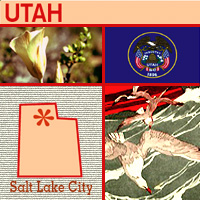 Utah Utah
The state known as Utah began when Brigham Young led
a group of Mormon pilgrims seeking freedom from
religious persecution into the Great Salt Lake
Valley, where they established a settlement in 1847.
The state gets its name from the Ute, an Indian
tribe who lived there before the pioneers arrived.
The golden spike completing the first
transcontinental railroad line was driven at
Promontory, Utah, in 1869, leading to a further
influx of settlers. Utah was admitted as the 45th
state in 1896. The capital, Salt Lake City, is also
the world headquarters for the Church of Jesus
Christ of Latter-day Saints, and Mormons make up 70
percent of the population. The sego lily is the
state flower of the "Beehive State." |
|
Utah
State Flag
Utah's flag features the state seal against a field
of blue. The date 1847 is the year the Mormons came to Utah.
1896 is the year Utah became the 45th state.
The beehive on the shield is a symbol of hard work and
industry (the state motto is INDUSTRY, a beehive is the
official state emblem, and Utah's nickname is The Beehive
State).
A bald eagle (the United States national bird) perches atop
the shield as a symbol of protection in peace and war (the
eagle clutches arrows as a symbol of power). The sego lilies
on right and left of the beehive are a symbol of peace (sego
lily is also the state flower of Utah). A U.S. flag banner
appears on each side of the shield, representing Utah's
support to the nation. |
|
Source:
State Symbols USA |
|
|
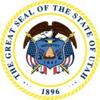 Utah
State Facts Utah
State Facts
Picture: state seal of Utah |
|
State Capital |
Salt Lake City |
|
Nickname |
Beehive State |
|
Motto |
Industry |
|
Statehood |
January 4, 1896 (45th) |
|
Origin of Name |
Taken from the name of the Ute Indians, whose name
means "people of the mountains" |
|
Largest Cities |
Salt Lake City, Provo, West Valley City, Sandy, Orem |
|
Border States |
Arizona, Colorado, Idaho, Nevada, New Mexico,
Wyoming |
|
Area |
82,168 sq. mi., 12th largest |
|
State Bird |
American Seagull |
|
State Flower |
Sego Lily (calochortus gunnisonii) |
|
State Tree |
Blue Spruce (picea pungens) |
|
State Song |
Utah, We Love Thee |
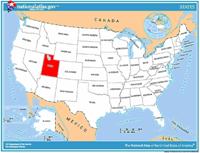 Travel and tourism site for
Utah - This state travel and territorial tourism site
provides ideas for your vacations, meetings, and more. Travel and tourism site for
Utah - This state travel and territorial tourism site
provides ideas for your vacations, meetings, and more. |
|
|
Utah Stories |
|
|
The Springville Museum Quilt Show
Are there any old quilts in your family? Quilts, which are often
passed down from generation to generation, can be an art form as
much as something that keeps you warm. A quilt could just as easily
be in a museum as it would be in someone's home.
Throughout American history, women who took care of their families
also have felt the urge to create art. They used materials they had
at hand -- mainly old clothes and rags from the household -- to
create quilts. Quilting has been a part of Utah history and culture
since pioneers settled in the Salt Lake Valley in 1847. The art of
quilting has been passed down from mother to daughter and friend to
neighbor since that time. Quilts can take hundreds of hours and
thousands of stitches to make.
Quilts made in the 1800s are very valuable today, and some people
collect quilts just like paintings or sculpture. The Springville
Museum in Springville, Utah, has an exhibit every year in June to
show off the quilting talents of local quilters. Many quilts tell a
story of daily life in Utah through colors and symbols.
To learn more about quilting, go to the "Join America at Play"
section of this Web site. |
|
|
Cowboy Poetry
Did you know that many cowboys pride themselves on their ability to
write and recite poetry? They are reading and writing "cowboy
poetry." What is that? Just as the name suggests, it's poetry
written by, for, and about cowboys. It describes what life was like
for a cowboy in the old days, as well as what life is like today.
The strong story content of cowboy poetry appeals to a mixed
audience -- other cowboys and cowgirls, ranchers, city dwellers and
farmers. This appeal has led to the growing popularity of the
Trementon Cowboy Poetry Roundup. Held in the Bear River Valley of
northern Utah, the roundup features local cowboys reading their own
poems as well as those of others. Each year 400 to 600 people attend
the event. You may have to be a cowboy (or cowgirl) to write cowboy
poetry, but anyone can enjoy it! |
|
|
Lamb Day
Can you guess why the kids in the photo are dressed as lambs?
They are participating in the Lamb Day parade in Fountain Green,
Utah. Sheep herding has historically been a popular way to earn a
living in Fountain Green. The town's people celebrate the local
sheep-herding community every year with a Lamb Day festival, which
first started in 1932. Sheep played a big part in the economy of
Fountain Green from the 1880s to the 1920s with the town playing a
leading role in lamb production worldwide.
Lamb Day features a lamb show and auction, a parade, a talent show,
a dance, games, and contests, including a one-mile race called the
"Lamb Scram" and a three-mile race called the "Wool Street Journey."
The festival highlight is the meal of lamb roasted for 12 hours in
special sandstone-lined pits first used 100 years ago. |
|
|
Bryce Canyon National Park, Utah
What's a hoodoo? Would you ever guess it has something to do with
rocks?
Utah's Bryce Canyon National Park owes much of its beauty and
character to the process of erosion -- the wearing away of a surface
by forces like water or wind. Hoodoos are strangely shaped pillars
that often resemble goblins or other supernatural characters. In
fact, the Paiute Indians, who lived in this region, called them
"Legend People."
Although they may resemble people, these rocks were formed by
nature. Water has physically and chemically broken down the ancient
rock of the Paunsaugunt Plateau by dragging bits of gravel and
debris across its surfaces and by entering small holes in the rock
and dissolving it. Various layers of rock differ in strength, so
erosion does not wear away at them all at the same rate. Therefore,
odd and irregular shapes have been formed. In addition to hoodoos,
other shapes include fins, spires, and pinnacles. |
|
|
Circle of Wellness
The circle is an important symbol for Native Americans. It
represents the four seasons, the heavens and the earth, the
universe, and the cycle of life. The idea behind the Circle of
Wellness organization is to keep Native American Indian traditions
alive, while helping Native Americans in Utah get a good education,
start businesses, and become satisfied members of their community.
More than 32,000 Native Americans live in Utah. They want to
remember their native history and traditions, which is why they
created a special cultural center to preserve these traditions and
unite the Utah Native American community. The circle was a good
symbol to choose for this center because a circle also stands for
mental, physical, spiritual and emotional health and the wholeness
of a community. |
|
|
Utah Pioneers
It's been called the largest human migration in American history. Do
you know what that refers to?
By 1869, perhaps 70,000 members of the Church of Jesus Christ of
Latter-day Saints, also known as Mormons, had walked or traveled in
wagons across 1,300 miles of wilderness to Salt Lake City, Utah.
Leaving 6,000 in graves along the way, the Mormons were searching
for religious freedom. Their journey was equal to the distance from
New York City to Miami, or Seattle to San Diego.
"This is the right place. Drive on." These were the words that
Brigham Young, top Elder of the Mormons, said on July 24, 1847, as
he lay sick in the back of a wagon. The place was the great valley
of the Salt Lake, in what would become the state of Utah. The
Mormons wanted to leave the persecution they faced in the eastern
part of the United States and start a community of their own out
west. Once Brigham Young and his band of 148 Mormons had found "the
place," more than 70,000 Mormons decided to follow.
Every year since 1849, Salt Lake City has remembered the Mormon
pioneers on Pioneer Day. In 1997, a Mormon wagon train re-created
the journey of these pioneers, to celebrate the 150th anniversary of
Brigham Young's arrival in Utah. The trip took three months! |
|
Source:
Library of Congress |
|
 National
Forests, Parks, and Monuments of Utah National
Forests, Parks, and Monuments of Utah
The following is a description of national
forests, parks, and monuments in the state
of Utah. If you plan to visit or live in
Utah for awhile then you should definitely
plan to visit some of these fantastic
places. |
|
|
|
National Forests |
 Ashley Ashley
Ashley National Forest manages the Flaming
Gorge National Recreation Area and the High
Uintas Wilderness. Kings Peak at 13,528 ft
(4,123 m) is the highest point in Utah and
is located in the Uinta Mountains. This
national forest is also partially located in
the state of Wyoming. |
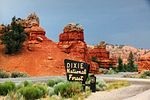 Dixie Dixie
Straddling the divide between the Great
Basin and Colorado River, Dixie National
Forest has elevations ranging from 2,800 ft
(850 m) near St. George to 11,322 ft (3,451
m) on Boulder Mountain. Ashdown Gorge,
Box-Death Hollow, Cottonwood Forest, and
Pine Valley Mountain wilderness areas are in
the forest. |
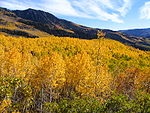 Fishlake Fishlake
Located in south central Utah, Fishlake
National Forest is named for Fish Lake, the
state's largest natural mountain lake. The
forest's Tushar Mountains reach their
highest point at 12,174 ft (3,711 m) on
Delano Peak. |
 Manti-La
Sal Manti-La
Sal
Including the La Sal and Abajo mountains of
eastern Utah, elevations in this forest
reach 12,721 ft (3,877 m) on Mount Peale.
The Dark Canyon Wilderness is the only
wilderness area in the forest. This national
forest is also partially located in the
state of Colorado. |
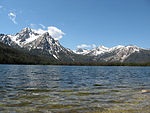 Sawtooth Sawtooth
Sawtooth National Forest includes over 1,100
lakes, 1,000 mi (1,600 km) of trails and
roads, and ten mountain ranges, with the
highest point at 12,009 ft (3,660 m) on
Hyndman Peak. The forest includes Sawtooth
National Recreation Area, the Sawtooth
Range, Sawtooth Wilderness, four ski areas,
and four endemic species, being found
nowhere else in the world. This national
forest is also partially located in the
state of Idaho. |
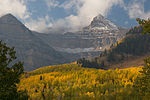 Uinta-Wasatch-Cache Uinta-Wasatch-Cache
There are nine wilderness areas in the
forest, which occupies part of the Wasatch
and Uinta mountains. Mount Nebo and Mount
Timpanogos are located in wilderness areas
at the edge of the Wasatch Front. This
national forest is also partially located in
the states of Idaho and Wyoming. |
|
|
|
National Parks |
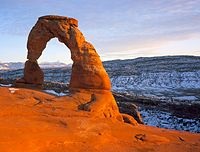 Arches Arches
This site features more than 2,000 natural
sandstone arches, with some of the most
popular arches in the park being Delicate
Arch, Landscape Arch and Double Arch.[14]
Millions of years of erosion have created
these structures located in a desert climate
where the arid ground has life-sustaining
biological soil crusts and potholes that
serve as natural water-collecting basins.
Other geologic formations include stone
pinnacles, fins, and balancing rocks. |
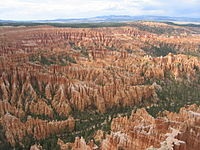 Bryce
Canyon Bryce
Canyon
Bryce Canyon is a geological amphitheater on
the Paunsaugunt Plateau with hundreds of
tall, multicolored sandstone hoodoos formed
by erosion. The region was originally
settled by Native Americans and later by
Mormon pioneers. |
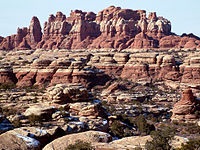 Canyonlands Canyonlands
This landscape was eroded into a maze of
canyons, buttes, and mesas by the combined
efforts of the Colorado River, Green River,
and their tributaries, which divide the park
into three districts. The park also contains
rock pinnacles and arches, as well as
artifacts from Ancient Pueblo peoples. |
 Capitol
Reef Capitol
Reef
The park's Waterpocket Fold is a 100-mile
(160 km) monocline that exhibits the earth's
diverse geologic layers. Other natural
features include monoliths, cliffs, and
sandstone domes shaped like the United
States Capitol. |
 Zion Zion
Located at the junction of the Colorado
Plateau, Great Basin, and Mojave Desert,
this park contains sandstone features such
as mesas, rock towers, and canyons,
including the Virgin River Narrows. The
various sandstone formations and the forks
of the Virgin River create a wilderness
divided into four ecosystems: desert,
riparian, woodland, and coniferous forest. |
|
|
|
National Monuments |
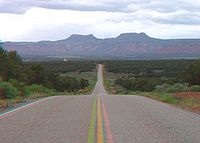 Bears
Ears Bears
Ears
Twin buttes, sandstone canyons, desert
mesas, forested highlands, rock art, ancient
cliff dwellings, ceremonial kivas. |
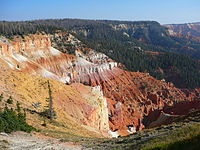 Cedar
Breaks Cedar
Breaks
A natural amphitheater canyon similar to
formations at Bryce Canyon National Park, it
stretches over 3 miles (4.8 km) and is more
than 2,000 feet (610 m) deep. |
 Dinosaur Dinosaur
This sandstone and conglomerate bed, known
as the Morrison Formation, was formed in the
Jurassic Period and contains fossils of
dinosaurs including Allosaurus and various
long-neck and long-tail sauropods. This
national monument is also partially located
in the state of Colorado. |
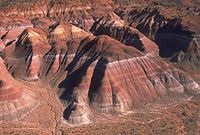 Grand
Staircase-Escalante Grand
Staircase-Escalante
Preserving 1,003,863 acres (4,062.49 km2),
the monument consists of the Grand
Staircase, the Kaiparowits Plateau, and the
Canyons of the Escalante. It is notable for
its paleontological finds and geology, and
it was the first monument to be maintained
by the Bureau of Land Management. |
 Hovenweep Hovenweep
Hovenweep contains six clusters of Native
American ruins. Holly Canyon, Hackberry
Canyon, Cutthroat Castle and Goodman Point
are in Colorado and Square Tower and Cajon
are in Utah. Ancient Pueblo Peoples lived in
the Hovenweep area from 1150 to 1350. This
national monument is also partially located
in the state of Colorado. |
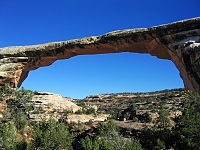 Natural
Bridges Natural
Bridges
Located at the junction of White Canyon and
Armstrong Canyon, it is part of the Colorado
River drainage. It features the second- and
third-largest natural bridges in the western
hemisphere, carved from the white Triassic
sandstone of the Cedar Mesa Formation that
gives White Canyon its name. |
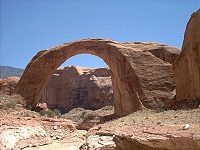 Rainbow
Bridge Rainbow
Bridge
Rainbow Bridge is one of the world's largest
natural bridges. It stands 290 feet (88 m)
tall and spans 275 feet (84 m) wide; the top
of the bridge is 42 feet (13 m) thick and 33
feet (10 m) wide. It was made from sandstone
formed during the Triassic and the Jurassic
periods. |
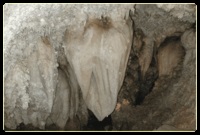 Timpanogos
Cave Timpanogos
Cave
The Timpanogos cave system is in the Wasatch
Range in the American Fork Canyon. Three
main chambers are accessible: Hansen Cave,
Middle Cave, and Timpanogos Cave. Many
colorful cave features or speleothems can be
seen, including helictites, cave bacon, cave
columns, flowstone, cave popcorn, and cave
drapery. |
|
|
|
|
Travel America |
|
|
Bryce Canyon National Park
(Beginner - Listening,
reading)
A video lesson which shows you an interesting place in America.
The English is
spoken at 75% of normal speed.
Great English listening and reading practice.
This video is all about Bryce Canyon National Park. |
Canyonlands National Park
(Beginner - Listening,
reading)
A video lesson which shows you an interesting place in America.
The English is
spoken at 75% of normal speed.
Great English listening and reading practice.
This video is all about Canyonlands National Park. |
Capitol Reef National Park
(Beginner - Listening,
reading)
A video lesson which shows you an interesting place in America.
The English is
spoken at 75% of normal speed.
Great English listening and reading practice.
This video is all about Capitol Reef National Park. |
|
|
|
|
|
|
|
|
Cool America |
 About the U.S.A. About the U.S.A.
About the U.S.A. is an American
Studies reader that examines the customs, government, and history of the
United States of America. The text provides a wealth of information on U.S.
geography and history; the roles of local, state, and federal government;
national holidays and symbols; the Constitution; and citizenship. The book,
which was written for intermediate to advanced learners of English, contains
a range of activities for language students to practice listening, speaking,
reading, and writing. (opens to a new PDF window)
Great English reading
practice. |
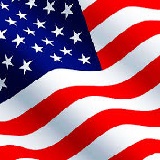 About
America About
America
Learn about the fascinating history and government of
the United States of America. Lessons include content on
American Government, American History, and Integrated
Civics. Handouts with interactive games and
student-centered activities encompass all four language
skills: speaking, listening, reading, and writing.
Great English reading practice for
beginning to intermediate students. |
 American Teens Talk! American Teens Talk!
Americans Teens Talk! is a collection of interviews of
American high school students. Each interview is accompanied by vocabulary
notes and discussion questions. The interviews in American Teens Talk! give
learners a view into the lives of adolescents in the U.S. Through the
written format of the interviews, learners are able to increase their
vocabulary, practice their reading and listening skills, engage in
discussions, and learn more about U.S. culture. These
interviews come with audio programs.
Great English listening and
reading |
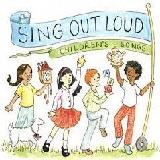 Sing Out Loud Children's Songs Sing Out Loud Children's Songs
Sing Out Loud Children's Songs includes popular children's songs in the U.S.A. Posters accompany the
individual Sing Out Loud Children's Songs. These
songs come with audio programs.
Great English listening and reading
practice. |
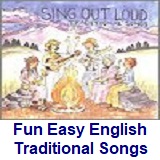 Sing Out Loud Traditional Songs Sing Out Loud Traditional Songs
The Sing Out Loud Traditional Songs
collection contains 13 traditional American folk songs and song lyrics.
Listen to the songs online, read the lyrics, and collect the posters that
accompany the songs. These
songs come with audio programs.
Great English listening and reading
practice. |
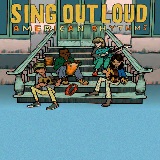 Sing Out Loud American Rhythms Sing Out Loud American Rhythms
Do you love music? Want to use it
to learn English? Check out the hip-hop inspired song "Peace" from Sing Out
Loud American Rhythms. American Rhythms includes a variety of musical genres
from many different artists in the U.S.A. These songs will appeal to teens
and young adults. These
songs come with audio programs.
Great English listening and reading
practice. |
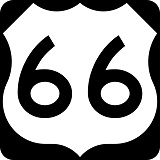 Route
66 - Famous American Road Route
66 - Famous American Road
U.S. Route 66 (US 66 or Route 66), also known as the Will Rogers Highway, the
Main Street of America or the Mother Road, was one of the original highways in
the U.S. Highway System. The highway, which became one of the most famous roads
in the United States, originally ran from Chicago, Illinois, through Missouri,
Kansas, Oklahoma, Texas, New Mexico, and Arizona before ending in Santa Monica,
California, near Los Angeles, covering a total of 2,448 miles (3,940 km). It was
recognized in popular culture by both the hit song "(Get Your Kicks on) Route
66" and the Route 66 television show in the 1960s. |
Route 66: The Highway That's the Best
(Beginner - Listening)
A video lesson which shows you an interesting place in America.
The English is
spoken at 75% of normal speed.
Great English listening practice.
This video shows travel along Route 66, the most famous road in
America. |
Chicago: The Start of Route 66
(Beginner - Listening)
A video lesson which shows you an interesting place in America.
The English is
spoken at 75% of normal speed.
Great English listening practice.
This video shows travel along Route 66, the most famous road in
America. |
Going West for Decades on Route 66
(Beginner - Listening)
A video lesson which shows you an interesting place in America.
The English is
spoken at 75% of normal speed.
Great English listening practice.
This video shows travel along Route 66, the most famous road in
America. |
Arizona: The Spirit of Route 66
(Beginner - Listening)
A video lesson which shows you an interesting place in America.
The English is
spoken at 75% of normal speed.
Great English listening practice.
This video shows travel along Route 66, the most famous road in
America. |
Route 66 California: The End of the Trail
(Beginner - Listening)
A video lesson which shows you an interesting place in America.
The English is
spoken at 75% of normal speed.
Great English listening practice.
This video shows travel along Route 66, the most famous road in
America. |
Ten Must-See Route 66 Attractions
(Beginner - Listening)
A video lesson which shows you an interesting place in America.
The English is
spoken at 75% of normal speed.
Great English listening practice.
This video shows travel along Route 66, the most famous road in
America. |
Four Famous Foods On Route 66
(Beginner - Listening)
A video lesson which shows you an interesting place in America.
The English is
spoken at 75% of normal speed.
Great English listening practice.
This video shows travel along Route 66, the most famous road in
America. |
International Tourists Drawn to Route 66
(Beginner - Listening)
A video lesson which shows you an interesting place in America.
The English is
spoken at 75% of normal speed.
Great English listening practice.
This video shows travel along Route 66, the most famous road in
America. |
|
|
|
|
Search Fun Easy English |
|
|
|
|
|
|
|
|
|
|
|
|
|
|
|
About
Contact
Copyright
Resources
Site Map |